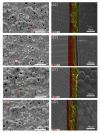Study on Enhancing the Corrosion Resistance and Photo-Thermal Antibacterial Properties of the Micro-Arc Oxidation Coating Fabricated on Medical Magnesium Alloy
- PMID: 36142610
- PMCID: PMC9503942
- DOI: 10.3390/ijms231810708
Study on Enhancing the Corrosion Resistance and Photo-Thermal Antibacterial Properties of the Micro-Arc Oxidation Coating Fabricated on Medical Magnesium Alloy
Abstract
Photo-thermal antibacterial properties have attracted much attention in the biomedical field because of their higher antibacterial efficiency. Through fabricating micro-arc oxidation coatings with different treating current densities set on a Mg-Zn-Ca alloy, the present study tried to systematically investigate and optimize the corrosion resistance and photo-thermal antibacterial properties of MAO coatings. The results indicated that different current densities had great influence on the corrosion resistance and photo-thermal property of the MAO coatings, and a current density at 30 A·dm-2 exhibited the best corrosion resistance, light absorption capacity at 808 nm, and photo-thermal capability, simultaneously with good antibacterial activity against Staphylococcus aureus (S. aureus) and Escherichia coli (E. coli). This photo-thermal property of MAO coatings was probably related to the effect of current density on MgO content in the coating that could promote the separation of photo-generated electron carriers and hinder the recombination of photo-generated electron carriers and holes.
Keywords: anti-bacteria; corrosion resistance; magnesium alloy; micro-arc oxidation; photo-thermal therapy.
Conflict of interest statement
The authors declare that they have no known competing financial interests or personal relationships that could have influenced the work reported in this paper.
Figures














Similar articles
-
Corrosion resistance and antibacterial activity of zinc-loaded montmorillonite coatings on biodegradable magnesium alloy AZ31.Acta Biomater. 2019 Oct 15;98:196-214. doi: 10.1016/j.actbio.2019.05.069. Epub 2019 May 31. Acta Biomater. 2019. PMID: 31154057
-
In vitro degradation and antibacterial property of a copper-containing micro-arc oxidation coating on Mg-2Zn-1Gd-0.5Zr alloy.Colloids Surf B Biointerfaces. 2019 Jul 1;179:77-86. doi: 10.1016/j.colsurfb.2019.03.023. Epub 2019 Mar 16. Colloids Surf B Biointerfaces. 2019. PMID: 30952018
-
Nanopatterned silk-coated AZ31 magnesium alloy with enhanced antibacterial and corrosion properties.Mater Sci Eng C Mater Biol Appl. 2020 Nov;116:111173. doi: 10.1016/j.msec.2020.111173. Epub 2020 Jun 9. Mater Sci Eng C Mater Biol Appl. 2020. PMID: 32806249
-
Advances in functionalized polymer coatings on biodegradable magnesium alloys - A review.Acta Biomater. 2018 Oct 1;79:23-36. doi: 10.1016/j.actbio.2018.08.030. Epub 2018 Aug 25. Acta Biomater. 2018. PMID: 30149212 Review.
-
[Research Progress of Micro-arc Oxidation Surface Treatment of Magnesium Alloy].Sheng Wu Yi Xue Gong Cheng Xue Za Zhi. 2016 Oct;33(5):1016-9. Sheng Wu Yi Xue Gong Cheng Xue Za Zhi. 2016. PMID: 29714960 Review. Chinese.
References
-
- Kopp A., Smeets R., Jung O., Kröger N., Klink A. Defined surface adjustment for medical magnesium implants by electrical discharge machining (EDM) and plasma electrolytic oxidation (PEO) CIRP Ann. 2019;68:583–586. doi: 10.1016/j.cirp.2019.04.016. - DOI
MeSH terms
Substances
Grants and funding
LinkOut - more resources
Full Text Sources

